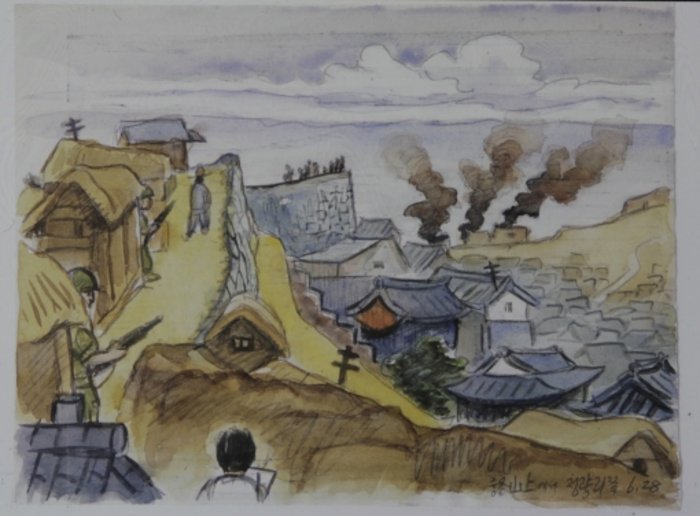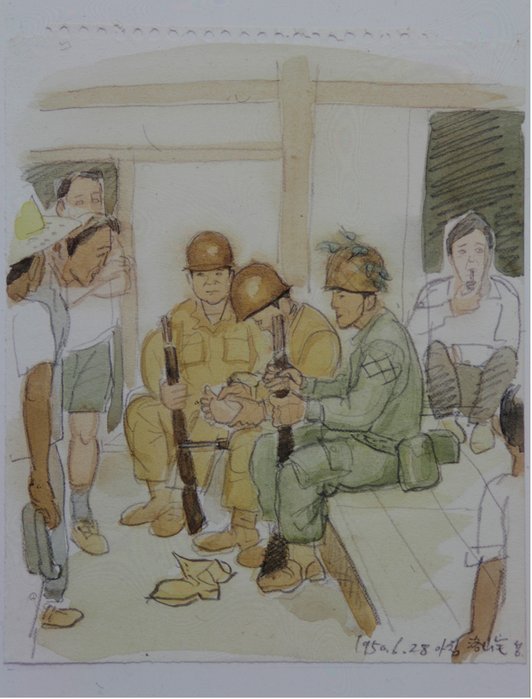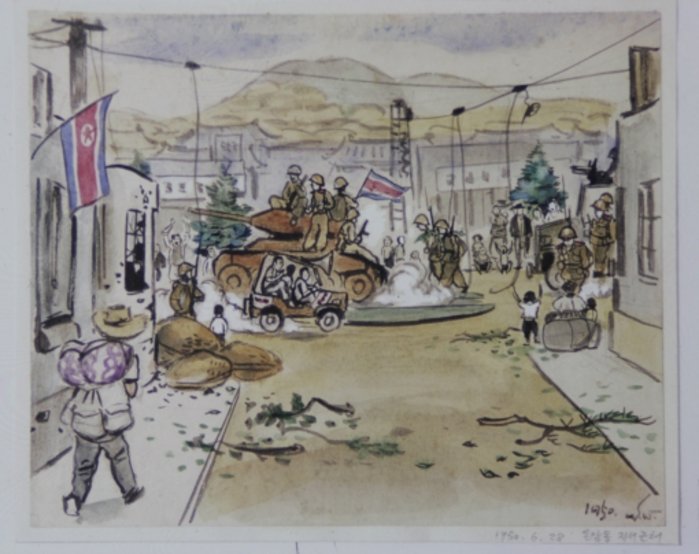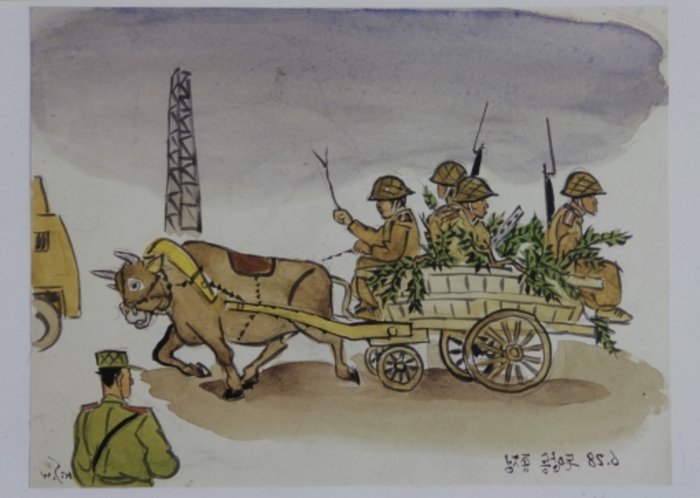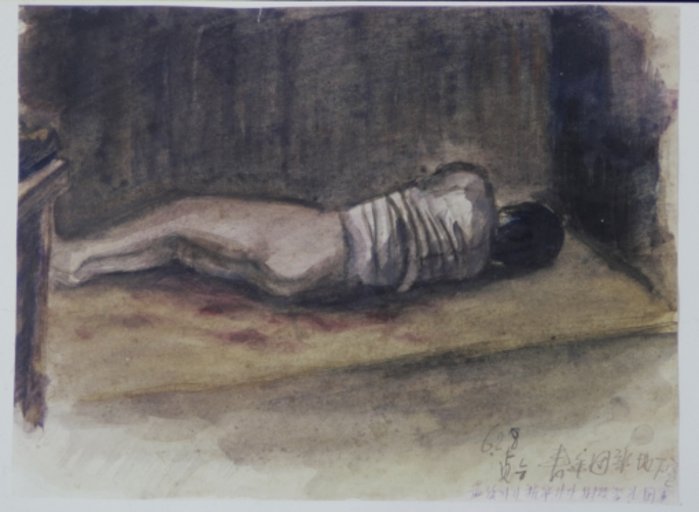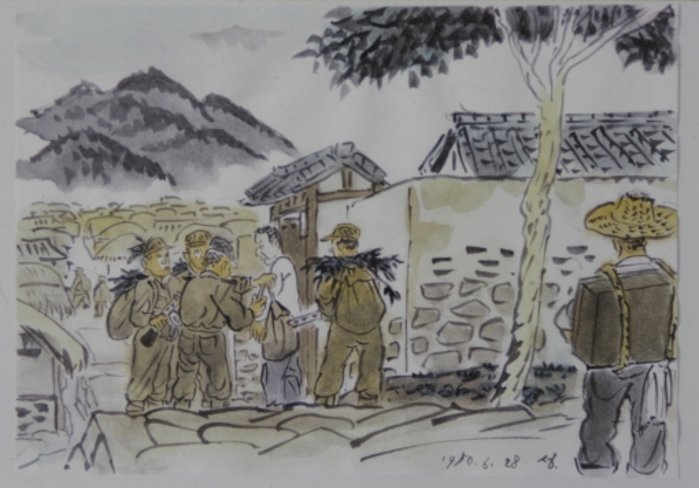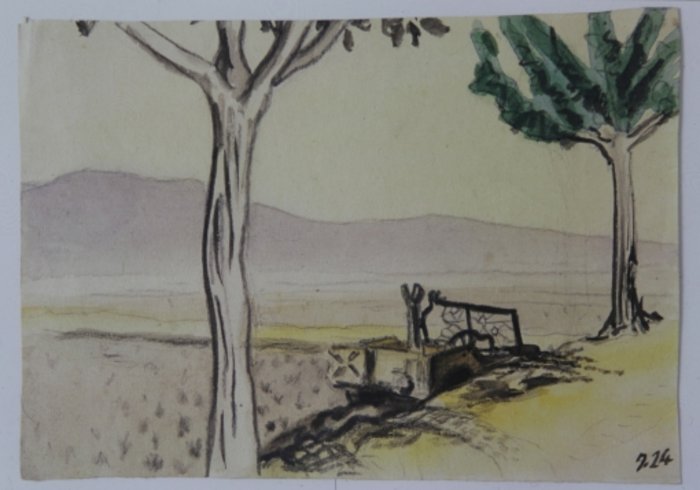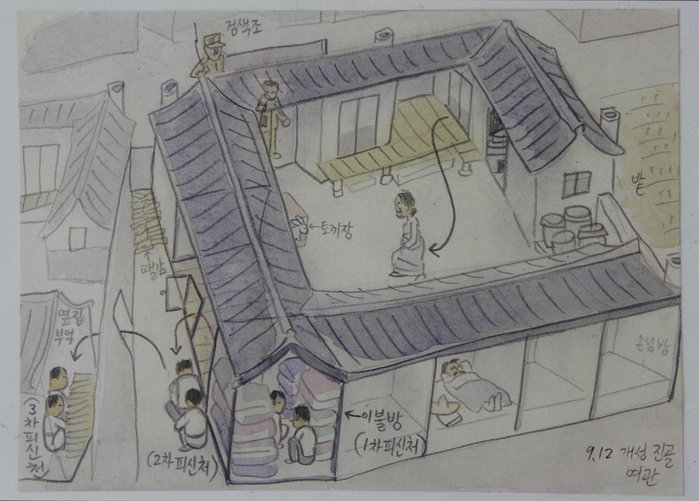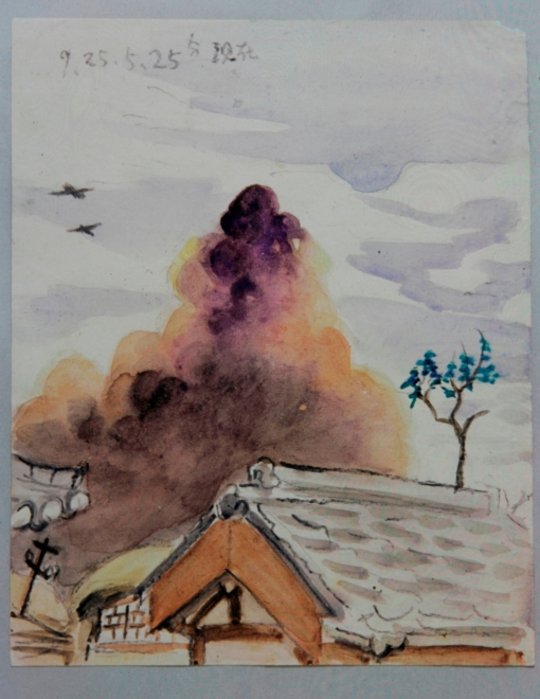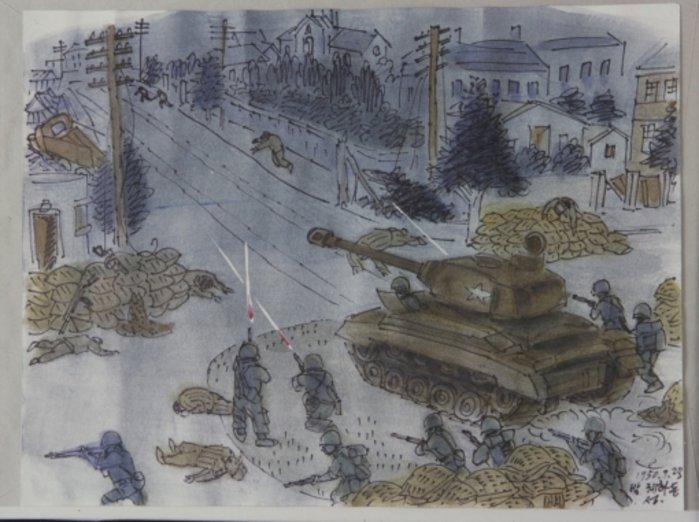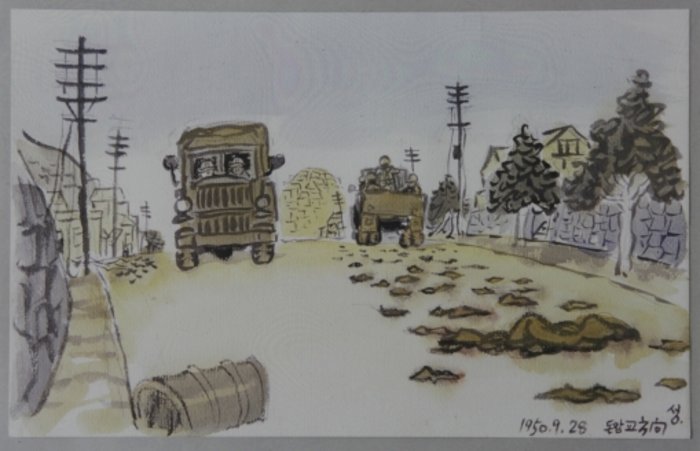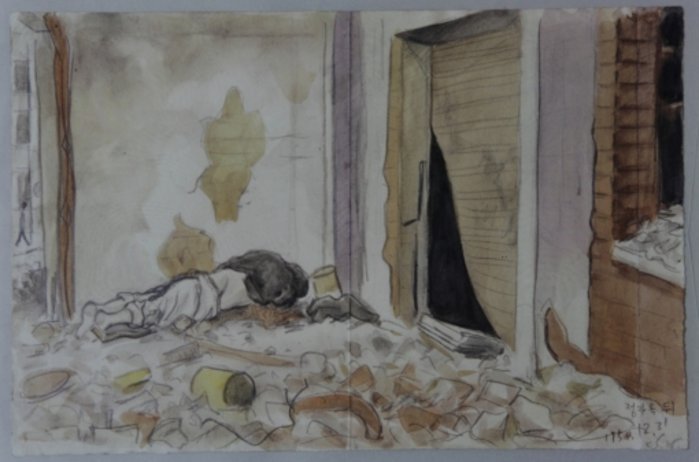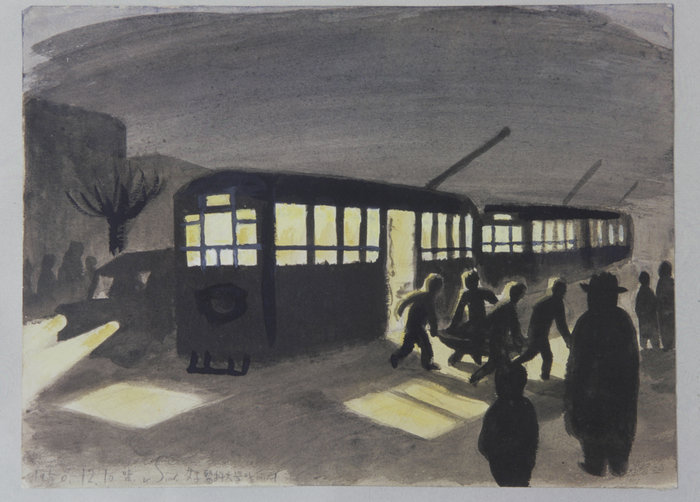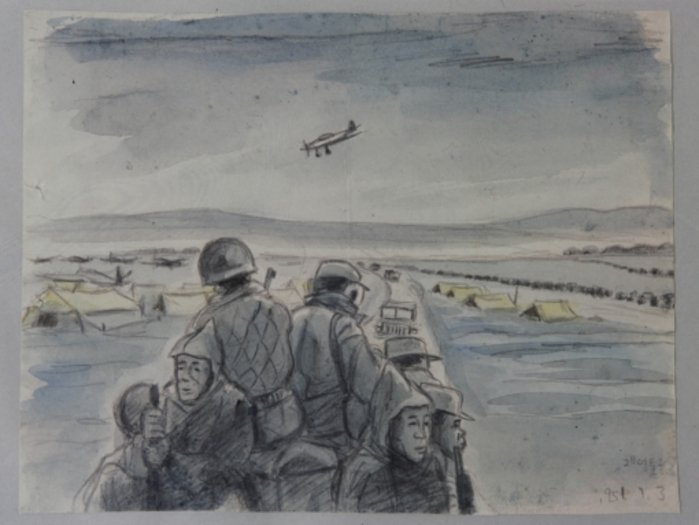A Cartoonist at War: “Gobau’s” Korea, 1950
Andrew Salmon
Next year, 2010, marks the 60th anniversary of the outbreak of what is aptly called “The Forgotten War.” While Kim Il-sung’s invasion of the Republic of Korea in the early hours of June 25th, 1950, ignited the first hot war of the cold war – and the first and only war in which the two superpowers would clash on the battlefield – it is a war that is almost dead to the public mind and popular culture of the western world.
It was a savage war in a devastated land; a war that was civil, ideological and even racial in nature, a war that sucked in fighting men from as far afield as Columbia and China, Ethiopia and Russia. It was a war in which entire US units were annihilated, an intense war which generated casualties far in excess of those incurred in today’s conflicts in Iraq and Afghanistan. Yet despite its many dramatic elements – and despite the fact that it has never really ended – Korea never achieved the same status in the western mind as did the wars that bookmarked it: World War II and Vietnam.
There are many reasons for this. World War II was the war of tank divisions and bomber fleets, of Churchill’s cigar and Hitler’s salute – and of a relatively clear morality. Vietnam was the war of the helicopter and the guerilla, of anti-war protest and colour TV coverage – and of very opaque, or at least fiercely contested, morality. Korea, on the other hand, lacked branded images or tactical innovations. The war’s ethical rights and wrongs are still debated – nowhere more so than in South Korea, where the shift in the ideological compass during the recent decade of liberal/leftist-nationalist (take your pick) rule sparked renewed interest in old – often suppressed – controversies.
With its 60th anniversary imminent, it is fair to say that the Korean War has generated little of the quality literature or film that defined perceptions of World War II or Vietnam. Moreover, those films and photographs that have made their way into books and museums are largely of and by Western – predominantly American – soldiers. Across the bamboo curtain, many Chinese photographs are clearly posed propaganda shots.
But what of those caught in the middle? There is even less visual imagery available that depicts the lives of the civilians swept up in the cataclysm.
Kim Sung-hwan, 78, is Korea’s most famous living cartoonist. For years, his work graced this country’s two major newspapers; he was twice interrogated under the authoritarian regimes and 200 of his strips were expunged. He has been lauded by fellow cartoonists including Malaysia’s “Lat” and Britain’s Frank Finch; films have been made of his output; and PhD dissertations on his work reside at Harvard and Kyoto universities. Today retired, with his collection displayed at South Korea’s National Museum of Contemporary Art, this cheerful and sprightly little man can rest on his laurels.
Things were not always so comfortable. Kim’s pen name “Gobau” (“Strong Rock”) came to him in the summer of 1950, when, as an 18-year-old, he was hiding out from North Korean troops. A high-school student and part-time magazine illustrator when North Korea invaded, he recorded the dramatic events of those days in unique style: with that blend of delicate Oriental watercolours and the sensitive pen cartoons that would later become his trademark. After Seoul’s September 28th 1950 liberation, he was employed as a war artist by the Ministry of Defence, but it is his early sketches that capture what it was like to be a civilian on the peninsula in the midst of total war. The collection reproduced below is one of the few extant galleries of Korean artwork that depicts the Korean tragedy; it has had, according to the artist, little or no exposure beyond South Korean and Japan.
This is “Gobau” at war.
The Holocaust Begins: The war is a day old. In the hills above Gobau’s hometown north of Seoul, two men watch distant artillery bursts. “We heard on the radio that the North Koreans had invaded, but were told that the South Korean Army had pushed them back,” said Gobau. “Because of that, many people did not flee.”
Joining the Fight: Republic of Korea, or ROK, troops head north to join the fight, some in a commandeered and camouflaged bus. They are woefully equipped: Gobau remembers that their helmets were not even metal, but made of some kind of cork. “It was nonsense!” he said.
On the Roads: Refugees, aware that the North Korean People’s Army (NKPA) is bearing down on Seoul, flee. Many are carrying their possessions in bundles on their head. Tragedy would strike when the Han River bridges were blown while refugees were crossing. Even so, the summer exodus would not be as terrible as the winter retreat six months later.
The Fighting Draws Closer: Not everyone fled. Near East Gate, curious onlookers (including Gobau, in foreground) watch as the NKPA approachs, while nervous Republic of Korea (ROK) troops take up firing positions overlooking the gate and its nearby market.
The Collapse: It is three days into the war and the ROK Army, outgunned and outfought, is breaking. Some ROK troops fought tenaciously: Men of General Paik Sun-yup’s crack 1st Infantry Division, defending the “Munsan Corridor” north of Seoul, strapped explosives to their bodies and, in an eerie echo of the World War II Imperial Japanese Army tactics that Paik, an IJA veteran, was intimately familiar with , hurled themselves under tanks. Such heroism was rare, however; these men are getting out. “They came into my father’s friend house so they could change their clothes,” said Gobau. “Note that some have blisters on their feet from the retreat. Looking back, though, they were calmer than most: Many ROK soldiers had no idea what to do.”
Hide the Guns! Civilians collect ROK troops’ rifles to bury them as the NKPA approaches. “The soldiers scattered after chancing into civilian clothes,” said Gobay. “The could see tanks coming, and they knew their rifles were no good against tanks; They were as pale as dead men!”
All Hail, Kim’s Men! It is June 28th. The war is less than three days old, but Seoul has fallen. The NKPA, mounted on Russian T34s, march triumphantly through the streets. “Some workers welcomed them – they thought it would be a different world – but not as many as I thought,” said Gobau. “There were NKPA going by in jeeps saying ‘Give them a big hand!’ but it was only some workers and children who did.” Sophisticated Seoulites would soon be chuckling to hear of the thirsty NKPA troops who mistook the Chosun Hotel’s toilets for drinking fountains.
The Men from the North: Gobau got a much closer look at the NKPA than any Western correspondent. Here he sketches the conquerors and their equipment. Note the Soviet Shpagin PPSH “burp guns” (so named for he brrrpp noise they make) and the tanks and scout cars – the ROK Army had no response to this mobile and armoured foe. Note the staring eyes of two of the subjects: The ‘1000 yard star’ is a common symptom of battle shock.
Tactical Bullock Cart: While photos and newsreels focussed on the NKPA’s formidable T34s, behind the armoured spearhead, the echelons relied on more tradtional transport – such as this well-camouflaged bullock cart. These methods were not alien to the “Great Leader” himself: Kim Il-sung had learned his warcraft in the Red Army, which, during World War II, had made effective use of horse-drawn Panje carts in the rough terrain of the Eastern Front.
The Naked and the Dead: Abandoned by his retreating comrades, a ROK soldier lies in a pool of blood. “Although there were two hospitals nearby, all the doctors had fled,” said Gobau. The man had been screaming and crying so much, local civilians had stripped him to find his wounds, then attempted to bandage him. The attempts were in vain: by the time Gobau sketched him, he was dead.
Killed in Action. Dead ROK soldiers lie on the battlefield, covered in the ubiquitous rice weave sacking. “There were flies everywhere,’ said Gobau. “Some bodies attracted more than others – maybe the flies liked fresh blood…”
Desolation: Bodies and mourners in the rice fields. The war is still in its early stages but the “collateral damage” is already mounting. Much greater destruction is soon to come.
Crimson Harvest: The fighting has passed. A stretcher is cleansed of blood.
The Pale Man: NKPA root out potential enemies in Gobau’s neighbourhood. Gobau (looking on from around the corner) remembered how very pale the South Korean looked as he was surrounded by the North Korean squad; he has no idea what the man’s eventual fate was.
The Americans Join the Fight: The Americans have landed in the south, but their early attempts to stem the advancing NKPA meet with no more success than those of their ROK allies. The US Army is no longer the formidable fighting force it was at the end of World War II; the men sent to Korea are ill-trained, under-motivated and softened by occupation duties in Japan. However, the US Air Force is to be reckoned with: Within a week of its deployment, it has hacked the North Korean air force from the sky. With desperate combat underway down south, NKPA administration in Seoul begins to break down; food runs short. Gobau decides to travel north to his aunt in Gaesong. On the way he sketches this scene: NKPA troops take cover and open fire on USAF aircraft dominating the skies. “They had little chance of hitting anything, but they fired anyway,” he said.
Low Level: The result of USAF intervention is soon apparent. Not only did the skies belong to the Americans, the NKPA was denied daylight use of the roads. In the summer of 1950, strafed vehicles became a common sight along the dirt tracks of the peninsula.
Burning Bridges: A ROK armoured car and a NKPA tank stand next to a blown bridge.. Gobau is unsure how the NKPA armour was knocked out, given the paucity of firepower mounted by the ROK vehicle. “Maybe it was a mine,” he said.
Attack Run: Dressed as peasants, North Korean soldiers collecting the rice harvest scatter as a US F80 Shooting Star screams in on a strafing run. The NKPA ruse of disguising themselves as civilians – a ruse that would later also be used by the Chinese – would create major problems for UN Command units who could not distinguish friend from enemy, and would have terrible repurcussions for civilians caught in the crossfire of an increasingly brutal war.
Family Tragedy: A man sobs; his wife has been beaten to death, perhaps by the NKPA, but like so many war stories, Gobau is unsure exactly who the assailant was. “He was an old man, and he was crying so much, I could not find out what had happened,” he said.
Shooting Stars over Kaesong: Framed by the traditional roofs of Kaesong, Korea’s ancient capital, US F80 Shooting Stars dive into the attack. “The bombing attacks were not that serious,” said Gobau. “They were aiming mainly at the rail station.” With the NKPA breaking its teeth on the stiffening defences of the “Pusan Perimeter,” the USAF effectively interdicted supplies and reinforcements heading for the battlefront.
Hideout: By late August, the fighting along the Naktong River is reaching its climax. The NKPA is being heavily attrited as it tries desperately to break through to Pusan and finish the war. To replace its horrendous casualties, the NKPA resorts to forcible recruiting of southern civilians. Gobau spent weeks in hiding in his attic; when he did go out, he carried a stick, to fool NKPA press gangs into thinking that he was unfit for duty. It was during those long, lonely hours spent reading and sketching that the young artist’s pen-name, “Gobau” (”Strong/Stubborn Rock”) came to him.
Escape Route: A fascinating sketch of the inside of Gobau’s aunt’s Kaesong house – actually, a yogwan, (inn) – during the NKPA occupation. The guests can escape the North Korean recruiting parties in the room piled high with ibul (blankets) and out the window into the back alley. “The neighbours were in on it – they kept their doors open!” said Gobau. Note the rabbit in his cage in the courtyard – a typical Gobau detail.
Into the Furnace: Gobau is passing through Munsan Rail Station while North Korean soldiers – unarmed, such is the parlous state of the NKPA supply lines, bombarded by the USAF – head south. This picture – sketched a day before MacArthur’s men landed at Incheon – strongly indicates what has long been suspected: The NKPA were aware of the upcoming Incheon assault on 15th September, around which security was notoriously lax. Why, then, did they not resist the US Marines more fiercely at the harbour? The answer is almost certainly that by this stage of the war, the NKPA lacked any effective maneuver element. Even so, they would fight hard in the streets and alleys of Seoul.
Bullock Vs Bike: A furious NKPA officer threatens a farmer on a bullock cart that has collided with his motorcycle sidecar combination. “The farmer was begging for his life,” recalled Gobau. “The NKPA man was out of his mind: Everybody knows how long it takes a bullock to stop or turn. The war was going badly for them.”
Counterattack: It is September. MacArthur has landed at Inchon, and his finest troops – the US 1st Marine Division – are fighting for the capital against North Korean diehards. Huge swathes of the city are devastated.
A Terrible Beauty: USAF rockets make a spectacular display against the lurid sunset as the battle for Seoul rages.
Darkness, be my Friend: Not every NKPA soldier was a fanatic. While Kim Il-sung’s stormtroopers in the early months of the war had proven – like the Imperial Japanese Army before them – to be both valiant and brutal fighters, by September thir combat effectiveness had been degraded. Pummelled from the air, and caught in a vise between the Inchon landing and the breakout from the Pusan Perimeter, many units melted away. Here North Korean soldiers – apparently unarmed – move out under cover of darkness.
Firepower vs Manpower: US Marines with tank support clear an NKPA roadblock at Daehangno intersection, central Seoul. Gobau did not witness the actual combat, but deduced what had happened by the position and the condition of the NKPA corpses scattered over the street the following day.
Aftermath: Seoul has been cleared of enemy, but the city has not yet been cleaned up. What looks like garbage in the foreground is actually human detritus: An NKPA soldier had been blown apart with explosives, then squashed flat by tank treads.
The Migooks are Here! Seoul has been liberated; Gobau sketched these portraits of GIs in the aftermath of the fighting. “When I first saw American soldiers, I thought they were all really old, in their 40s or 50s,” Gobau recalled. “I later found out there were only in their 20s – it was just that they were so heavily bearded!” Another reason for Kim’s confusion may have been the men’s facial expressions: Troops suffering from battle stress commonly appear older than their actual age.
The Defeated: In front of Myong Dong Cathedral, North Korean prisoners in their underwear are marched off to an uncertain fate. The NKPA had behaved brutally in the areas under its occupation – its victims included captured GIs, who were found bound and neckshot – but the atrocities were not all on one side. Both during the retreat down the peninsula, and on the fight back up it, ROK paramilitaries had shown little mercy for captured communists or traitors – or suspected communists or traitors.
Settling Scores: Not all the dead were victims of the war – or even of political violence. In the lawless aftermath of the battle, this man, lying in the Midopa Department Store was killed, Gobau believes, by the notorious Jongno gangsters. By now, the young water colourist had been hired as a war artist; he got some very odd looks as he wandered the streets sketching dead bodies.
Children of the Ruins: “This car had no engine, and no wheels, but there were these two children living in it,” recalled Gobau. In the days before NGOs such as the Red Cross got fully active in the South, orphaned or abandoned children had to rely on the kindness of strangers – including UN troops, many of whom temporarily adopted homeless children – or their own wits to survive. But with the NKPA smashed and UN forces charging North to finish the war, surely, things would soon return to something approaching normality?
Streetcar Casevac: It is December. The fighting in the North has turned – disastrously – against the UN Command. Wounded ROK soldiers are evacuated to a Seoul Women’s University Hospital by tram. On December 30th, Seoul civilians will be ordered to flee the capital once again.
The Bleakest Midwinter: Catastrophe has struck. Out of the freezing north, China attacked. Defeated and demoralized, UN forces have given up North Korea in hopes that the victorious communists will halt at the 38th parallel. The hopes were in vain: Peng Te-huai stormed south on New Year’s Day. Gobau was embedded with these ROK troops on Yeoiudo Airfield as they await evacuation down the Han River on tank landing craft, and thence to the sea, and the south. “The troops had transport,” Gobau recalled. “But the civilians…” With the UN Command employing scorched earth tactics, and vengeful NKPA joining the Chinese thrust south, as many as a million civilians – many of them old people, women and children – joined a trek south through a pitiless winter. On the day Gobau sketched this scene, the UN rearguard – Royal Northumberland Fusiliers, Royal Ulster Rifles and 8th Hussars – were engaged in a desperate battle outside Koyang: “Happy Valley.” In that single day and night of combat, the battlegroup lost more men killed or missing than the British Army lost in eight years in Afghanistan. Yet by the standards of the Korean War, this was considered a small action. And the carnage still had two and a half years to run.
Seoul-based reporter Andrew Salmon is the author of To The Last Round: The Epic British Stand on the Imjin River, Korea, 1951 (Aurum, London, 2009). He is currently working on a prequel, Year of the Tiger: The Commonwealth Versus Communism, Korea, 1950.
This article, prepared for The Asia-Pacific Journal, is an expansion of a piece by Salmon that ran in Seoul’s English-language Joongang Daily newspaper on June 25th, 2008. A gallery of Gobau’s work can be seen on the author’s website. All works are held at South Korea’s National Museum of Contemporary Art; they are reproduced with the permission of the artist.
Recommended Citation: Andrew Salmon, “A Cartoonist at War: ‘Gobau’s’ Korea, 1950” The Asia-Pacific Journal, Vol. 28-3-09, July 13, 2009.







